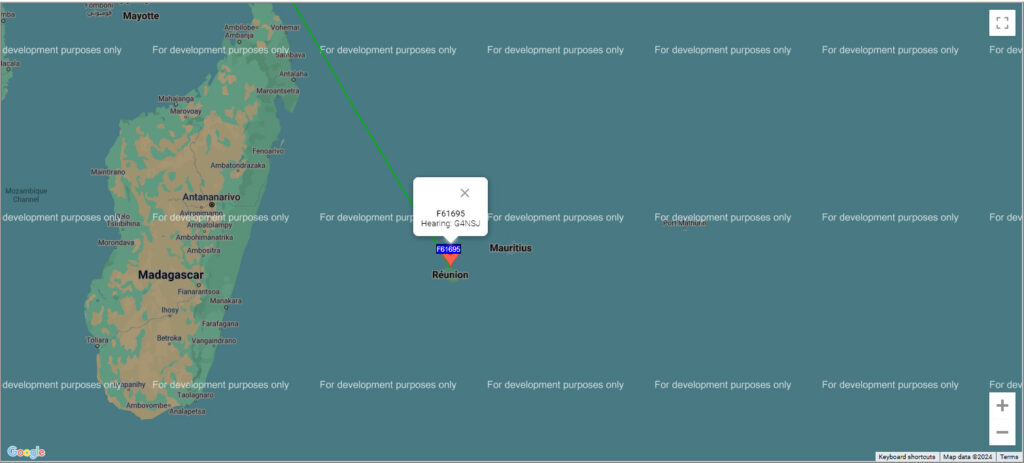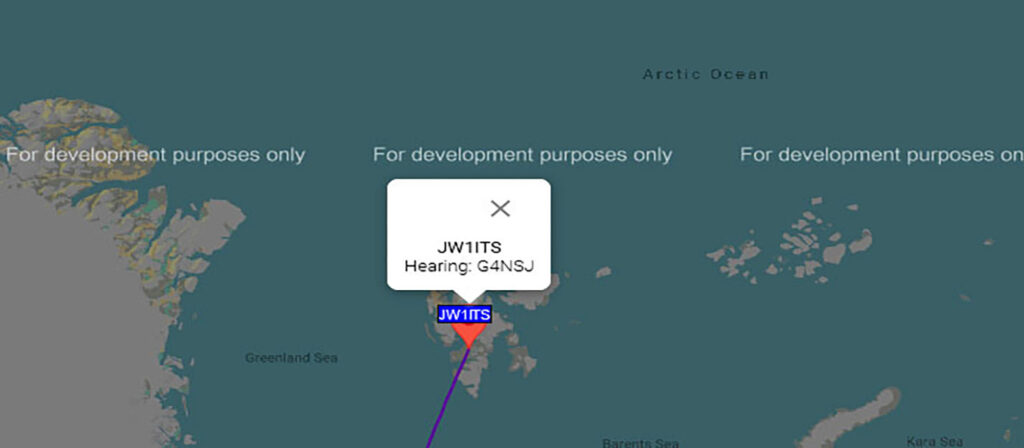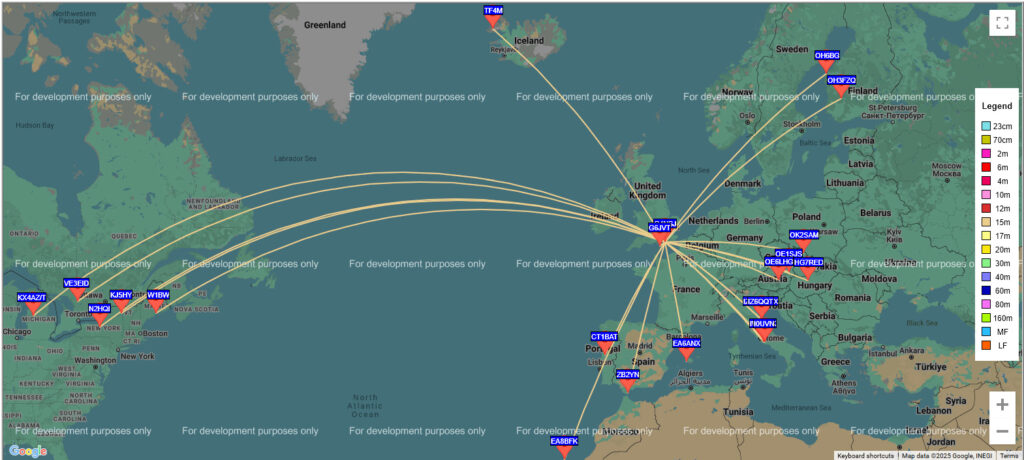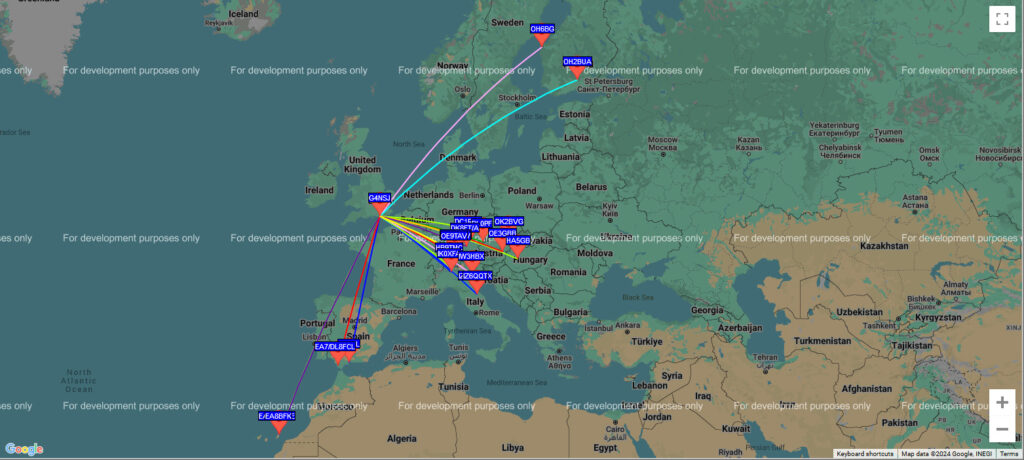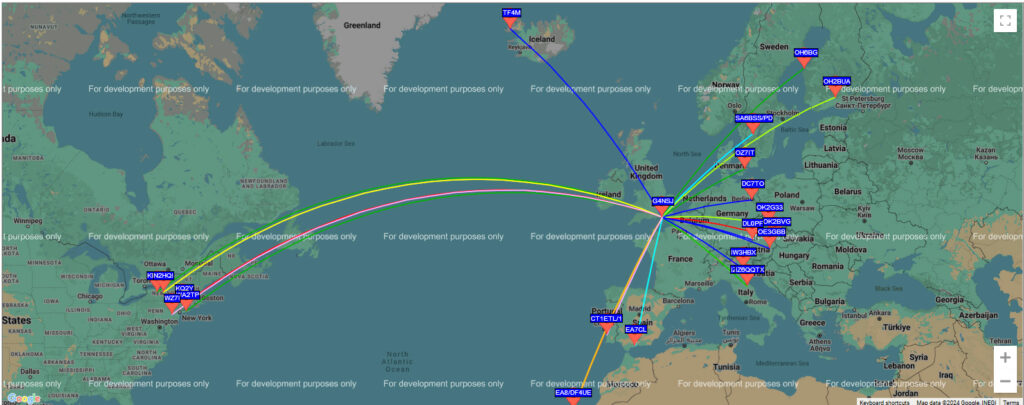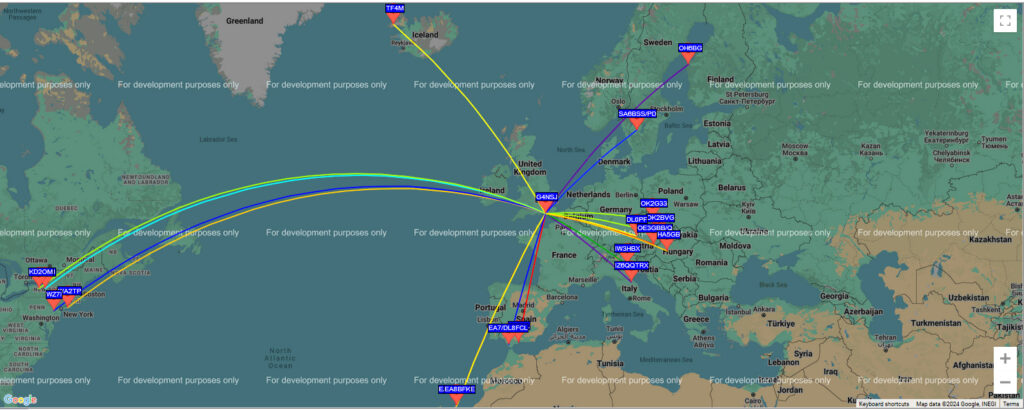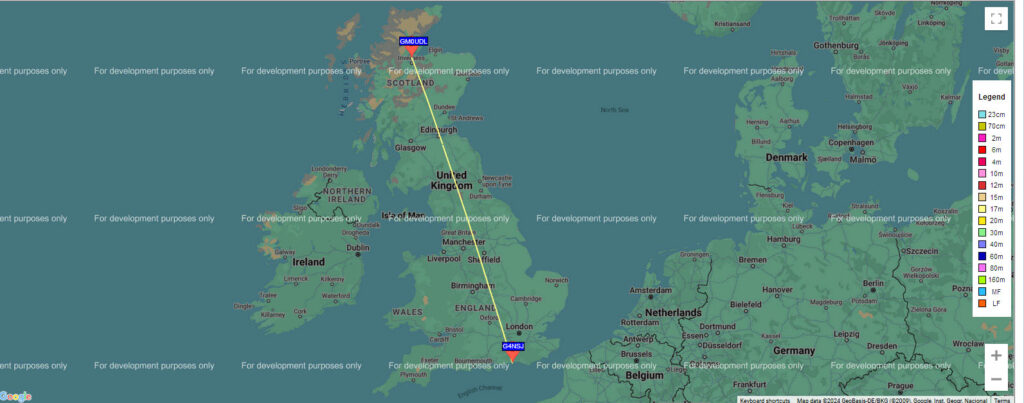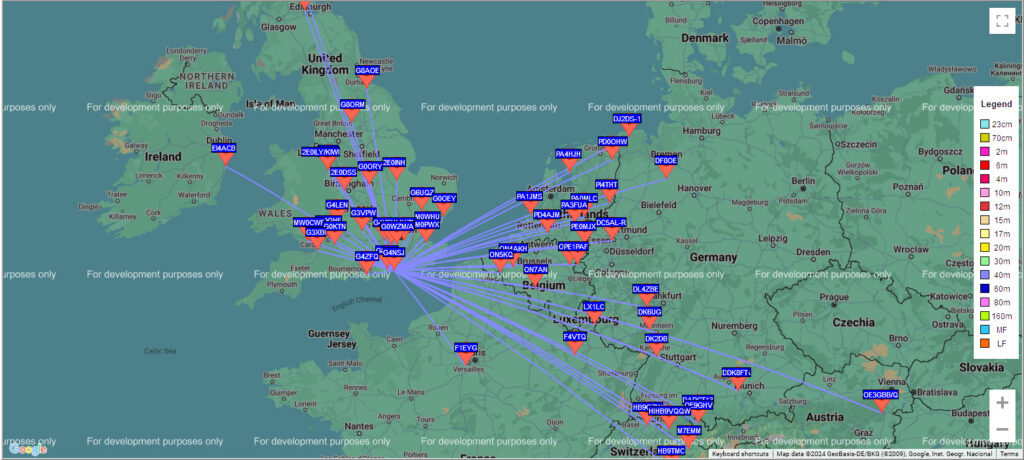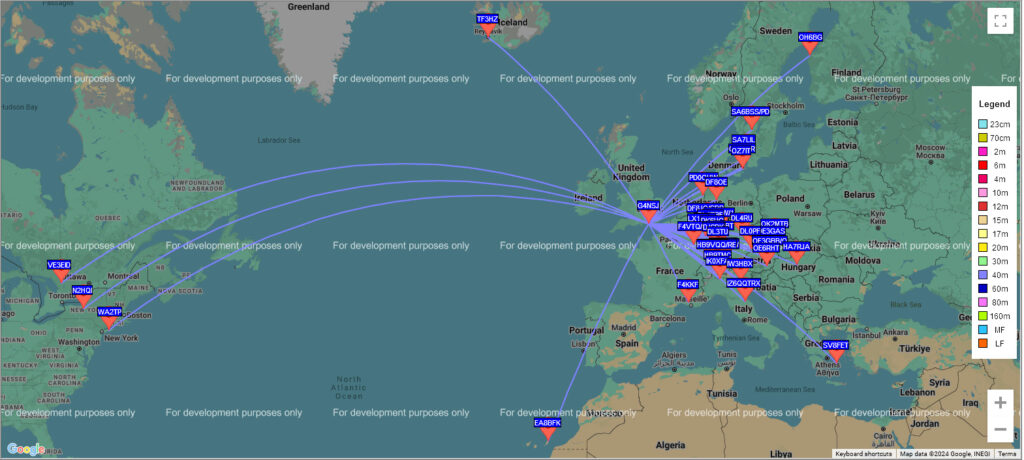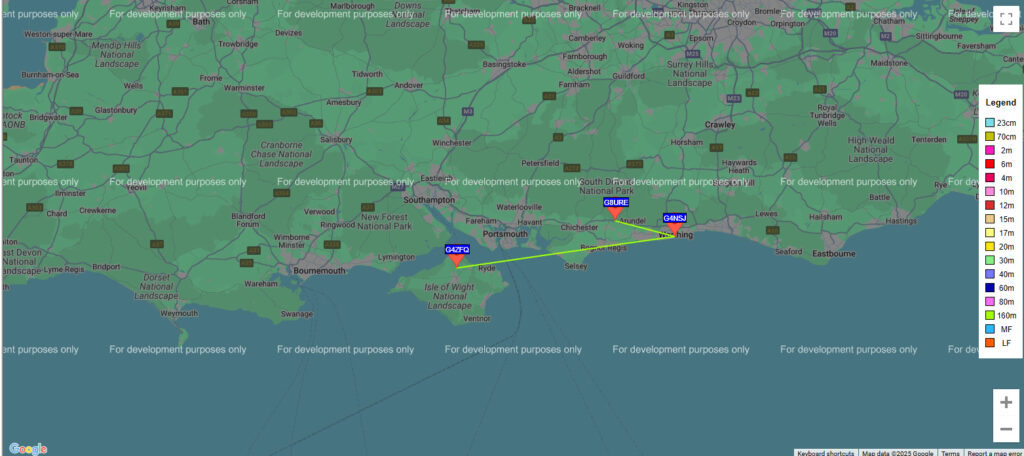Audio Introduction:
Video at bottom of page
WSPR (whisper) Desktop Transmitter:
13/12/24. I’ve taken delivery of a WSPR DesktopTransmitter from Zach Tek. Take a look at the link for information. It’s a standalone multi-band WSPR transmitter with built-in GPS. Well worth buying if you’re into WSPR. With this little unit, I’m able to transmit continuously from any location. All I’ll need is an aerial and a 5 Volt power supply.
Available models:
The model I have is the 40To6. It covers bands 40m, 30m, 20m, 17m, 15m, 12m, 10 and 6m.
2190To80 for bands 2190m, 630m, 160m and 80m (136kHz, 474kHz, 1.8MHz and 3.5MHz)
80To10 for bands 80m, 40m, 30m, 20m, 17m, 15m, 12m and 10m.
SWR and the Zach Tek Desktop Transmitter:
Apparently, the transmitter can withstand infinite SWR. This good news if you are band-hopping or if your antenna isn’t properly matched. However, the radiated power could be down to single digit milliwatts due to reflected power.
Going mobile on 10 metres:
When on holiday, I intend to use the TX in the car on 10 metres using a 1/4 vertical antenna. I travel around the Isle of Wight every year so that should be interesting. Hopefully, the GPS signal will place me at the correct location on the WSPRnet online map. Mobile info here.
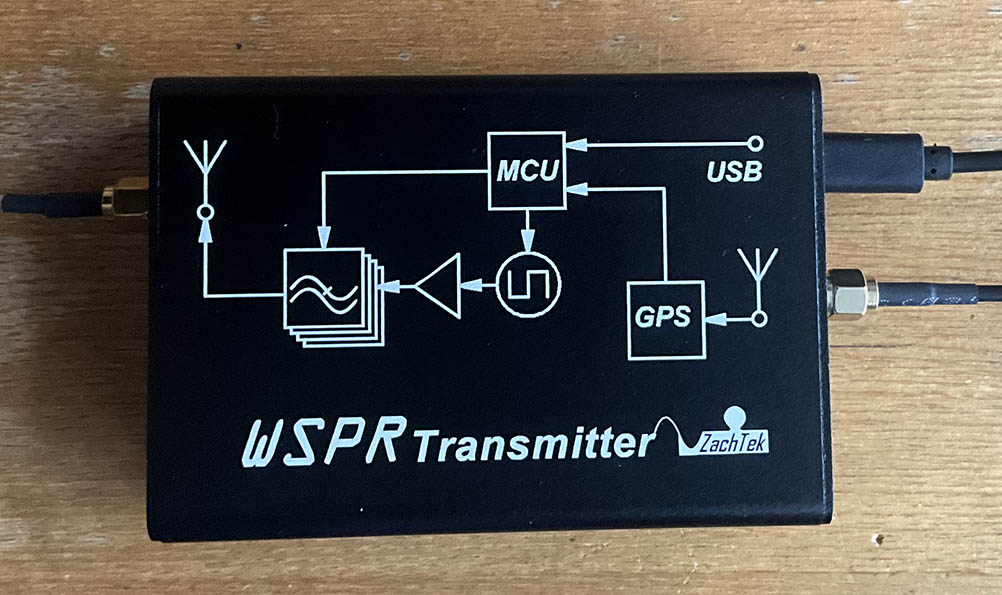
WSPR History:
WSPR was designed and a program written initially by Joe Taylor, K1JT. WSPR was released in 2008. The software code is now open source and developed by a small team. The program is designed for sending and receiving low-power transmissions to test propagation paths on the MF and HF bands.
Propagation:
The WSPRnet online map is perfect for checking propagation. The map refreshes every 20 minutes. Say you’re on 10 metres and you wish to work Australia. Keep an eye on the map and, when you see stations from your part of the world hearing and being heard in VK land, it might be possible to have an SSB contact with Australia. Bear in mind that propagation varies from day to day. You can also use WSPR for comparing different antennas. You might find my space weather page interesting. You might also wish to see the PSKReporter map, which is very useful.
Power level:
If you’re transmitting WSPR, there’s no point in running 100 Watts or more. If you keep the power as low as possible, you’ll have a more accurate indication of propagation. The Zach Tek TX runs around 200mW. This is more than enough on all bands.
Get started with WSJT-X:
You don’t have to be a licensed radio amateur to use the WSPRnet online map or the WSJT-X computer program for receiving stations. You can login as a short wave listener and the stations you hear will be shown with your icon on the map.
Receiving with WSJT-X:
If you are only interesting receiving, and you don’t have a radio with a USB connection for a computer, don’t worry. You can take audio from your receiver, via the headphone socket for example, and feed that into your computer’s line or microphone input. You will need to go into the WSJT program on your computer and choose the correct audio input settings. On the screen, you will need to tick the box marked ‘upload spots’ so your icon and the stations you hear will be shown on the WSPRnet map. Also, your PC must be connected to the internet.
TX and RX WSJT-X:
If you wish to transmit, you will need a radio with a USB connection to connect to your computer. Once you’ve downloaded the program, you will see ‘prefer type 1 messages‘. Leaved this ticked to transmit 4 characters of your locator – IO90. If you untick this box, you will transmit 6 characters – IO90TT. When I’m mobile with the Zach Tek TX, I transmit G4NSJ/M with a 6 character locator.
Remember, the USB dial frequency on your radio is 1.5 KHz lower than the transmitted frequency (the centre frequency). You need to take the centre frequency you want to decode and subtract 1.5 KHz to calculate the Dial Frequency for USB.
Formula:
USB Dial Frequency = TX centre Frequency – 1.5 KHz
Example: Dial Freq = 5.250 MHz – 1.5 KHz = 5.2485 MHz
WSPR decoding is done +- 100Hz of the centre frequency.
It is usual to quote the Centre frequency and the operator needs to calculate the correct dial frequency.
USB dial frequencies in MHz:
0.136. 0.4742. 1.8366. 3.5686. 5.3647. 7.0386. 10.1387. 14.0956. 18.1046. 21.0946. 24.9246. 28.1246. 50.293. 70.091. 144.489. 432.300.
I’m hearing them but they’re not hearing me:
Quite often, you’ll see that you are hearing stations on the WSPRnet online map but they aren’t hearing you. The reason could be that they are transmitting but not receiving. When I’m using my Zach Tek mobile on 10 metres, it transmits but it doesn’t receive. Looking at the map, it will show that you hear me but I don’t hear you.
Comparing Antennas:
HF Propagation can change quickly so carry out antenna comparison tests over short periods of time. Bear in mind that you don’t know what type of antenna is being used at the receiving end. However, there are stations that monitoring continuously with fixed antennas. When you’re carrying out tests over several days, test at the same time of day.
A very interesting website:
Check this out, it’s all about Interpreting WSPR Data.
A QRP antenna tuner:
Check out my page on a QRP ATU for use with the Zach Tek transmitter. This ATU will ensure you get the maximum power from the TX to the antenna. Below is my WSPR set-up running on 10 metres.
The photo below shows two Zach Tek transmitters, running on 10 metres and 30 metres, with their QRP ATUs. Thanks to Nick for the loan of the TX on the right. Interestingly, on the first night of running WSPR on 30 metres, I discovered that the band was open to America all night. This is encouraging as I plan to use digital modes such as Olivia on this band.
All times are in GMT (UTC – Z)
Propagation results.
Transmitting 200mW on 6 metres, 50.2945MHz. The antenna is a Diamond V2000 Tri-Band antenna at 6 metres AGL.
13/12/24. 0900 – 1300 hours:
Zero results. Hopefully, 6 metres will open up and some point.
Propagation results.

Transmitting 200mW on 10 metres, 28.1261MHz. The antenna is a 5/8 vertical 2 metres AGL.
Early Morning:
14/12/24. 0930 hours.
Neumayer Station 3 Antarctica. This was an amazing result. Check out Neumayer Station 3, Call sign DP0GVN/1. They are listed on QRZ. Check their excellent Website for information and photos.
Afternoon:
Early afternoon good for Australia and Tasmania, also good for Madagascar area. Sweden, Finland and Iceland still good at 1330 hours. Mid to late afternoon good for South America. The path to North America, mainly East Coast to Missouri, has been good from midday until late afternoon.
13/12/24. 1345 hours.
Reunion Island.
14/12/24. 1300 hours.
Svalbard, up near the Arctic Circle. I was being heard in Svalbard. JW1ITS, in International WSPR Beacon Project.
15/12/24. 1530 hours.
Brazil and Canary Islands still good. The path to South America closed at 1600 hours.
Late Afternoon Early Evening:
15/12/24. 1700 hours.
The last two paths open to the Canary Islands and North Carolina. At 1730 hours, only the Canary Islands remained open. Strangely, at 1830 hours, the path to North Carolina opened again. This is what I find fascinating about propagation. One minute, a path is open to Australia, the next minute, that’s closed and you’re chatting to someone in North America. If you want DX contacts, you have to be quick!
As darkness falls, the path to North America begins to close. At 1840 hours I’m only being heard in Long Island and Philadelphia. Bear in mind that propagation changes, not only at different times of the year but, daily. The last station to hear my transmission after dark was in the Canary Islands. That path closed at about 1800 hours. Bear in mind that it’s winter here, it’s dark at 1630 hours.
Night Time:
During the night, the 10 metre amateur band here in the U.K. is dead. Apart from one or two locals chatting to each other.
![]()
Going Mobile:
I’ve been having great results going mobile on 10 metres. See the mobile page here.
Propagation results.
Transmitting 200mW on 12 metres, 24.9246MHz. The antenna is a 5/8 vertical 2 metres AGL.
Midday:
11/2/25. 1200 hours:
Canada, South America, Finland, Sweeden…

Propagation results.
Transmitting 200mW on 15 metres, 21.0946MHz. The antenna is a 30 metre long end-fed at 5 metres AGL.
Early Afternoon:
11/2/25. 1330 hours:
North Africa, Iceland, Italy, Michigan, New York, Finland, The Canary Islands, Austria…
AMAZING RESULTS!
AMAZING RESULTS WITH A MOBILE WHIP!
Transmitting 200mW on 15 metres, 21.0946MHz. The antenna is a mobile whip standing on the floor in the shack! More info and results here.
Propagation results.

Transmitting 200mW on 17 metres, 18.1046MHz. The antenna is a 30 metre long end-fed at 5 metres AGL.
Early Morning:
17/12/24. 0900 hours.
Canary Islands, Finland, Sweden. At 1100 hours, I was also heard Iceland.
Afternoon:
17/12/24. 1200 hours.
Band now open to New York.
17/12/24. 1500 hours.
The band hasn’t really changed since 1200 hours.
Evening:
Nothing had changed at 1800 hours, except my signal had also reached Edmonton in Canada. By 1830 hours, the path to Edmonton had gone.
17/12/24. 1945 hours:
The band finally closed.
Early Morning:
18/12/24. 0600 hours.
The band has been dead all night but I’m now being heard in Scotland. At o800 hours the path opened to the Canary Islands.
18/12/24. 0830 hours.
My signal is now reaching Finland, Spain, Austria and the Canary Islands.
Propagation results.
Transmitting 200mW on 20 metres, 14.0956MHz. The antenna is a 30 metre long end-fed at 5 metres AGL.
Results coming soon.
Propagation results.

Transmitting 200mW on 30 metres, 10.1401MHz. The antenna is a 30 metre long end-fed at 5 metres AGL.
Early Morning:
18/12/24. 0600 hours:
This band opens early, unlike the higher bands.
18/12/24. 0900 hours:
Open to New York this morning.
Afternoon:
18/12/24. 1500 hours:
Results on the map so far. It will be interesting as we go into darkness.
Evening:
18/12/24. 1930 hours:
The band is still open to parts of Europe.
18/12/24. 2100 hours:
The band finally closed. The last station to receive my signal was in the Canary Islands. As expected, this band opens earlier in the mornings than the higher bands and stays open longer in the evenings.
Propagation results.
Transmitting 5 Watts on 30 metres, 10.1387MHz, from my IC-7300. The antenna is an end-fed wire, 2 metres long, hanging from the ceiling in my radio room.
Afternoon:
17/2/25. 1512 hours:
This was an experiment to discover how well I could TX and RX with an antenna consisting of 2 metres of wire situated inside my radio room.
Propagation results.
Transmitting 200mW on 20 metres, 7.0401MHz. The antenna is a 30 metre long end-fed at 5 metres AGL.
20/12/24. 1300 hours:
Band open mainly to Europe.
20/12/24. 1900 hours:
Band now open to the Carnary Islands, Finland and Greece.
21/12/24. 0400 hours:
The band has opened to America and Canada. If you want to work the USA on 40 metres, get up early! The path to America and Canada closed at 0800 hours.
Propagation results.
Transmitting 200mW on 60 metres, 5.3647MHz. The antenna is a 30 metre long end-fed at 5 metres AGL.
10/2/25. 1500 hours:
The map shows signals not travelling any further than Europe. Conditions weren’t brilliant.
Propagation results.
Transmitting 1.6 Watts on 80 metres, 3.5686MHz. I’m using my Icom IC-7300 on the 80 metre band as the WSPR transmitter only goes down to 40 metres. The power is set at 0% which is about 1.6 Watts. The antenna is a doublet 30 metres long and 10 metres AGL.
20/12/24. 1915 hours:
Band open to Finland and Belarus. The band didn’t really change during the evening. Our street is host to hundreds of Christmas lights which were horrendously noisy so I switched off at 1000 hours.
Propagation results.
Transmitting 5 Watts on 160 metres, 1.8366MHz.
Out of interest, I’m trying WSPR on top band using my Icom IC-7300. My aerial is an end-fed wire, 30 metres long at 5 metres high… obviously not designed for 160 metres. In fact, it’s about 49 metres short! However, having a decent ATU, I can get 1:1 SWR. By the way, you can load a six inch nail on top band and get 1:1 SWR with a decent ATU. But, obviously, it will be a useless antenna. It will be interesting to try at night when the propagation is better.
12/2/25. 1300 hours:
I’m only being heard by a couple of stations and I’m not hearing anyone. However, as it’s the middle of the day, I’m not surprised.
VLF:
I tried my Miniwhip active antenna on two VLF frequencies. I heard F6KPL on 474.200KHz. I also monitored 136KHz but heard nothing.
Video. WSPR:
Conclusion:
I’ve enjoyed studying propagation on the various bands. However, the time has come to concentrate on one band. I’m now transmitting WSPR on 10 metres from my car. See the mobile page here.
WAB Whispered All Briton:
You’ve probably heard of WAB, Worked All Briton. How about WAB, Whispered All Briton. Here are the squares I’ve transmitted from on 10 metres mobile and been heard so far…
IO90SV – IO90RV – IO90TU – IO90ST – IO90RT – IO90JR – IO90JQ – IO90KQ – IO90KP – IO90JP – IO90IS – IO90IR
Here is an excellent web site.
Interpreting WSPR Data for Other Communication Modes.
The Maidenhead Locator
Thanks to those who have sent me the information below.
Manual Maidenhead Locator:
When I’m at my home QTH, I need to transmit the standard message. Callsign, and a 4 digit locator.
This requires one transmission sequence of two minutes duration.
The transmission carries callsign + 4 digit locator + dBm transmit power.
Auto Maidenhead Locator (GPS):
When I’m mobile, I need to transmit my callsign with the suffix /M plus a 6 digit locator.
This requires two consecutive transmission sequences of two minutes each.
The first transmission carries callsign + callsign + power or callsign + locator + power.
The second transmission carries hashed callsign + locator +power.
The receiving station will need to decode the first part before decoding the second part.
Some more information:
Transmissions always begin 1 second after even minutes.
The total bandwidth is about 6Hz.




